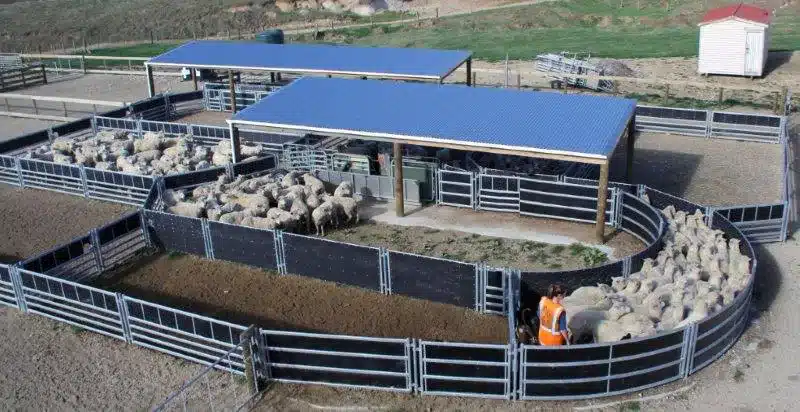The fundamentals of sheep yard design
Good sheep yard design is important for handling efficiency, animal welfare and providing a safe working environment for handlers. Put simply, an inefficient, cheap sheep yard will make sheep handling a grind. A well-built and efficient design will be better for sheep and more enjoyable for handlers. Let’s look at the fundamentals of good sheep yard design.
- Planning
Planning is essential for any new project, especially one where you’re making an investment in your business. You’ll want to see a return for your investment in higher productivity, less labour and happier, healthier sheep.
Do your research online, talk to workers about yards they enjoy working on, and visit other yards if you can. Your yard will always be different, as it has to suit your land and flock size, but you’ll learn a lot about what elements you’ll need for an efficient and safe yard for people and animals.
You’ll also need to plan when to build your new yard, especially if you’re replacing an existing yard. You’ll need to build it before it’s time for peak sheep work so there’s little or no disruption to your normal operations.
Tip: We have templates for sheep yards based on flock size to get you started.
- Planning handling zones and work areas
Nobody knows your requirements better than you. You know how many sheep you’ll need to handle and what jobs you need to do in the yard. Work flow benefits from good entry and egress points, and you’ll want to move mobs through the yard with the fewest obstacles, especially during busy periods when you’re handling several mobs at once.
Creating dedicated handling and work zones for each task is better than trying to create a one-size-fits-all yard. It makes handling easier, promotes efficiency and is much less stressful for the animals as they move through the yard.
You may also want to consider building individual sheep yards specific to each purpose for better flow. Yards for drenching and drafting work better at different sizes, again emphasising the point that a one-size-fits-all yard isn’t necessarily the best option. Several basic and built-for-purpose yards may be better than one complex and expensive yard.
Your design will also need to reflect the breed and temperment of your sheep. You may need higher rails and stronger fences for better control of the mobs as they move through the yard.
- Site selection
A common mistake people make when building new yards is to upgrade the existing yard as a like-for-like. Your old yard may be familiar, but it may not be the best design or in the best location on your farm. It’s likely that you’ll only ever build one new yard in your time managing your farm, so it pays to take the time to get it right.
Before you buy your components and prepare to build, ask yourself if there’s a better location for your yard. Your existing yard may not be the best location for the new one, even if it has been there for many years. You’ll want to build your new yard where there’s good drainage, shelter from weather events, and where you have access to water and power.
For long-term planning, do you have the capacity to increase your flock size? If so, you’ll need to consider the option of expanding your yard. Can the site accommodate a larger yard?
- Flow
No matter what jobs you need to do, aim to get your sheep moving through the yard in a familiar route and without having to negotiate multiple changes in the route at any one time. If sheep get stressed moving through the yard, they’re less likely to run, which makes the yard less efficient.
Use wide gates to encourage flow and position work points and handling areas along the points of the yard following a familiar route. Like many animals, sheep like routine. When the route, flow and handling points remain the same, they move better through the yard.
- Components and materials
Traditionally, permanent sheep yards are built from timber with steel gates, but now we have more innovative options. Building with steel components provides you with a robust sheep yard with the flexibility to alter the design or relocate the yard if your circumstances change.
No matter what size yard you’re building, get in touch if you need further advice. Our friendly team is here to help.

